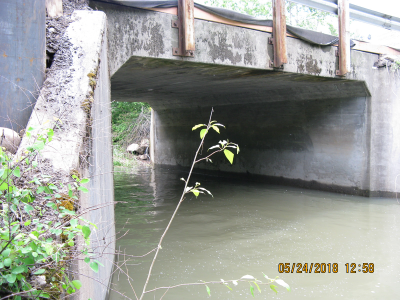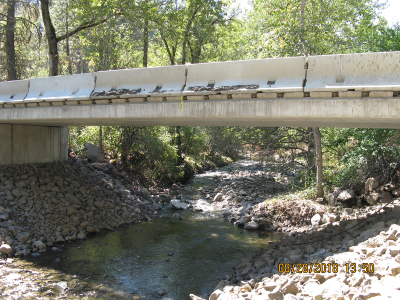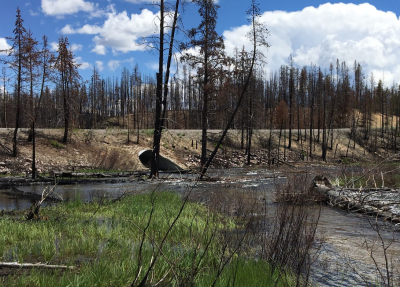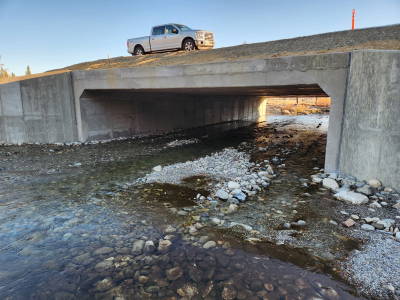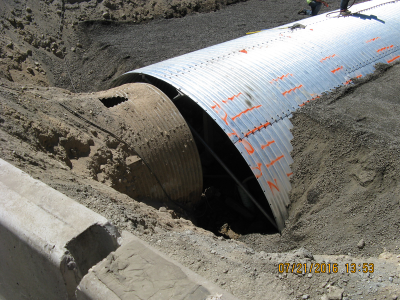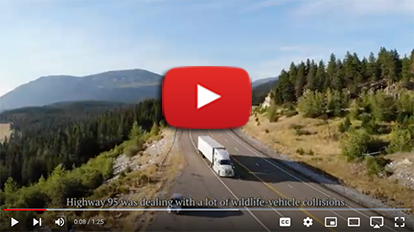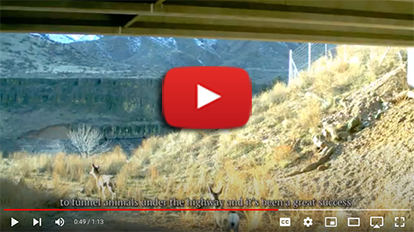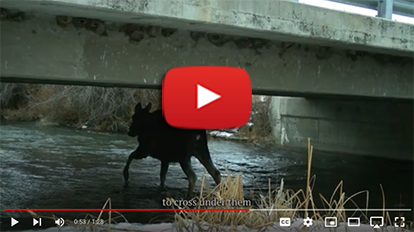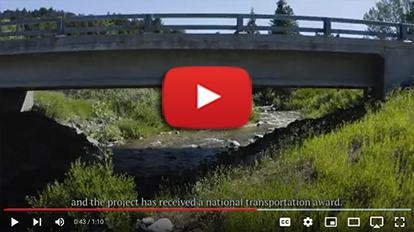Environmental | NEPA Process
Contacts | Quick Reference
What’s New
Reference for topics in tabs above
PEL Study – Planning & Environmental Linkages Study
NEPA – National Environmental Policy Act
Cultural
- Section 106: National Historic Preservation Act, Archaeology, Architectural History
- ITD History: Publications & Resources
Human & Physical Environment – Air Quality, Community, Environmental Justice, Hazardous Materials, Noise
Natural Environment
- Aquatic Resources
- Biological Resources
- Personnel Qualifications | Programmatic Biological Assessment (PBA) Info
- Memos & Standard Operating Procedures
- Outside Agency Master List
- Planning & Public Involvement
- Training
- Best Management Practices Manual
- Environmental Process Manual
Stormwater – Managing pollutants properly to protect surface waters
Wildlife – Mitigation for reducing risk to wildlife & prevent crashes
- Fish Passage & Wildlife Crossings
- Ongoing, future & completed projects
- For Cultural inquires send an email to: Cultural@itd.idaho.gov
- For all NEPA related questions send an email to: NEPA@itd.idaho.gov
- For all Stormwater notifications send an email to: HQ.ENVSWPP@itd.idaho.gov
| Environmental Services Manager | Aaron Scheff | 208-334-8629 |
| Biological Resources (Biology/Policy) | Julie Hausknecht | 208-334-8472 |
| Community Resources (Environmental Justice) | Ester Ceja | 208-334-8897 |
| Stormwater Program | Aquatic Resources | Sarah Hansen | 208-334-8551 |
| Architectural Historian | Susanne Perry | 208-334-8412 |
| State Highways Archaeologist | Marc Munch | 208-334-8449 |
| Archaeologist | Travis Pitkin | 208-334-8403 |
| NEPA Process | Vacant |
The District staff has knowledge in a broad range of areas including environmental analysis, threatened and endangered species, traffic noise, air quality, stormwater, wetlands mitigation, and permitting. They work directly with local, state, and federal agencies, along with the public in avoiding or minimizing project impacts. The planners prepare and coordinate environmental documents in compliance with NEPA.
Below are the Environmental specialists located at the six ITD districts within Idaho.
| DISTRICT 1 • North Idaho | Coeur d’Alene Office | Mike Hartz Sr. Environmental Planner | 208-772-8018 |
| DISTRICT 2 • North-Central Idaho | Lewiston Office | Shawn Smith Sr. Environmental Planner | 208-799-4268 |
| • North-Central Idaho | Lewiston Office | Neal Scott Environmental Planner | 208-799-4250 |
| DISTRICT 3 • Southwest Idaho | Boise Office, 8150 Chinden Blvd. | Greg Vitley Sr. Environmental Planner | 208-334-8952 |
| • Southwest Idaho | Boise Office, 8150 Chinden Blvd. | Chris Branstetter Environmental Planner | 208-332-7192 |
| • Southwest Idaho | Boise Office, 8150 Chinden Blvd. | Scott Rudel Environmental Planner | 208-334-8329 |
| DISTRICT 4 • South-Central Idaho | Shoshone Office | Connie Jones Sr. Environmental Planner | 208-886-7824 |
| • South-Central Idaho | Shoshone Office | Brett Sergenian Environmental Planner | 208-886-7832 |
| DISTRICT 5 • Southeast Idaho | Pocatello Office | Alissa Salmore Sr. Environmental Planner | 208-239-3312 |
| • Southeast Idaho | Pocatello Office | Chuck Heisler Environmental Planner | 208-239-3609 |
| DISTRICT 6 • East Idaho | Rigby Office | Chad Jensen Sr. Environmental Planner | 208-745-5602 |
| • East Idaho | Rigby Office | Graden Quist Environmental Planner | 208-745-5611 |
Transportation Committee for Environmental Consistency (TCEC) Forum is for environmental personnel from ITD, FHWA and the consulting community regarding transportation, environmental, procedural, and technical subjects. The group will host an informational coffee with predetermined discussion topics as listed in the schedule below.
These meetings foster communication between ITD environmental staff and consultants working on (or potentially working on) ITD projects. It is a way for the environmental professionals at ITD, Federal Highway Administration (FHWA), Ada County Highway District, Local Highway Technical Assistance Council, Army Corps of Engineers, and other partnering agencies to give updates on policies, regulations, processes, issues, statutes, work plans, etc.
Participants should bring discussion items related to the topic. Coffee and snacks will be supplied by presenters.
- Dates: 4th Thursday of every other month | Meeting Time: 9:00 – 10:30 a.m.
| Date | Topics | Location | Additional Information |
|---|---|---|---|
| May 12, 2022 | Julie will present the updated Programmatic Biological Assessment (PBA), including what has changed. She will provide an overview of the PBA Project Pre-Notification (ITD 0289) “smart” form and discuss a variety of tools that will be available to assist the districts and consultants through the process. • PBA Training Presentation **Please see the Natural Environment tab on this webpage for: • Personnel Qualifications • PBA and Appendices • PBA Biological Opinions • PBA Commitments Crosswalk Table | 9-10:30 a.m. TEAMS meeting | Presenters: Julie Hausknecht and Melinda Lowe, ITD Headquarters Senior Environmental Planners |
| February 24, 2022 | US Army Corps of Engineers | Recent and upcoming changes to Waters of the United States, 2022 Nationwide Permits renewal, and stream mitigation process. • Additional information: 2019 NWW Delineation Guidance • PowerPoint slide presentation • Play Meeting Recording (Microsoft Teams Meeting) | 1-3 p.m. TEAMS meeting | Shane Skaar, USACE Boise Regulatory Office |
| October 28, 2021 | Rocky Point Wildlife Crossing project | Bio-Engineering - Incorporating salmonid habitat into roadside streambank stabilization designs • Play Meeting Recording (1 hr. 20 min. - WebEx) | 9 AM WebEx meeting | Matt Pieron, ID Fish and Game Alissa Salmore, ITD District 5 Katie Salsbury, Intermountain Aquatics |
| August 26, 2021 | U.S. Army Corps of Engineers (USACE) jurisdiction based on the Navigable Water Protection Rule (NWPR), the implementation of the NWPR for common transportation projects, changes within the 2020 Nationwide Permit Program (NWP) applicable to transportation projects, and USACE Walla Walla District updates to Wetland and Stream Mitigation. | 9 AM WebEx meeting | Shane Skaar, US Army Corps of Engineers |
| July 1, 2021 | DEQ Primacy Transfer and PEL • Play Meeting Recording (61 min. - WebEx) • Idaho DEQ Primacy Presentation • Idaho DEQ Primacy Construction General Permit (CGP) DEQ Primacy Transfer - Idaho Department of Environmental Quality’s (IDEQ) primacy transfer, the Construction General Permit (CGP), and its implications for ITD. Administration of the EPA CGP transferred to IDEQ on July 1, 2021. What is changing, what stays the same, and looking forward to the 2022 CGP. PEL - Planning and Environmental Linkages (PEL) are a tool that allows Departments of Transportation to look at environmental and community resources that are intersected by a potential project’s footprint prior to starting NEPA. Due to the new timeframes for completion of Environmental Assessments and Environmental Impact Statements PELs will become a vital tool for ITD. | 9 AM WebEx meeting HQ Auditorium 3311 W State St. Boise, ID 83703 | Speakers: Matt Carlson, ITD HQ Stormwater SME Wendy Terlizzi, ITD HQ Environmental Services Manager |
| April 22, 2021 | Jacobs Digital Solutions for Improved Efficiency and Accuracy for Environmental Data Collection Play Meeting Recording (52 min. - WebEx) Presentation on custom digital tools developed by Jacobs programming and biology staff to improve efficiencies in delineation, surveys, and vegetation monitoring. Jacobs Omni is a mobile app that allows for digital collection of delineation data that reduces post processing of delineation datasheets and reporting. Jacobs also has developed several standard web applications for biological surveys and mitigation monitoring to collect, store, analyze, report project data and reference it geospatially if desired. | 9 AM WebEx meeting | Speakers: Gretchen Herron Neil Young & Peiter De Wolfe Jacobs Engineering |
| February 25, 2021 | ITD and IDFG working together on wildlife vehicle conflict data Play Meeting Recording (1 hr. & 12 min. - WebEx) Wildlife vehicle conflict (WVC) data in combination vehicle crash data and migration data from the Idaho Department of Fish and Game (IDFG) helps the Idaho Transportation Department (ITD) determine where wildlife mitigation could be placed within a highway project to protect the traveling public. In the spring in 2019, ITD District 4 developed a collection tool using the Survey123 application by ESRI that minimized the collected data and maximized the ease of reporting by the end user. Within the first year, ITD District 4 has seen a 321% increase in reported WVC's. By putting data collection into the hands of our employees and making data collection simplistic, employees have responded enthusiastically. Overall this application has given us more accurate data and more data points. With better data accuracy and density, we will be able to allocate resources more efficiently to minimize WVC's. | 9 AM WebEx meeting | Speakers: Wendy Terlizzi (ITD HQ Env Mgr) Brent Brumfield (ITD District 4 GIS) |
| October 22, 2020 | US Army Corps Walla Walla District and the Navigable Waters Protection Rule Play Meeting Recording (1 hr. & 55 min. - WebEx) Clean Water Act Section 401 Presentation Walla Walla District liaison, Shane Skaar, will provide a brief training on the new rule that went into effect in June. US EPA Region 10 and changes to Section 401 Water Quality Certification process | 8:30 AM WebEx meeting | Speakers: Shane Skaar, Walla Walla District ITD Liaison Linda Storm, EPA |
| July 23, 2020 | ITD/SHPO Disagreement Regarding Project Effects to Historic Highway & Favorable ACHP Comment Play Meeting Recording (52 min. - WebEx) The Federal Highway Administration (FHWA) Idaho Division Office and the Idaho Transportation Department requested to the Advisory Council on Historic Preservation (ACHP) to provide resolution of a dispute with the Idaho State Historic Preservation Office (Idaho SHPO) of the “Determination of Effect” finding for the construction of two additional lanes along a segment of United States Highway 93. Proposed project actions would create a four-lane roadway, divided by a median for 2.255 miles in Jerome County, Idaho. FHWA Idaho Division Office and ITD issued a “Determination of Effect” that project actions would constitute a “No Adverse Effect.” Idaho SHPO disagreed with the determination and had recommended an “Adverse Effect” finding. As further consultation to resolve this disagreement with Idaho SHPO reached a stalemate, the FHWA Idaho Division Office requested the ACHP to review the finding and concur with the finding of No Adverse Effect to Historic Properties. We will discuss how we worked in coordination with FHWA, SHPO, our consultants, and the ACHP to attain a positive outcome. | 8:30 AM WebEx meeting | Speakers: Matt Kriegl & Marc Münch, ITD |
| May 28, 2020 | LHTAC presented on recent successes in partnering with the Forest Service to provide for FHWA-required mitigation Play Meeting Recording (1 hr. & 26 min. - WebEx) Problem: Needed to find faster and more cost effective mitigation for projects that are FHWA-only mitigation that did not leave our local sponsors with a long term burden. Solution: Looked for regional partner with an already established environmental stewardship mission, that had a restoration project that created or restored wetlands that we could financially contribute to provide mitigation. Need willing and proactive partner, that owns the land or has a conservation easement on the land as well as a long term management plan. | WebEx only meeting | Speaker: Karissa Nelson (Hardy), LHTAC |
| March 26, 2020 | Cancelled | ||
| January 23, 2020 | ITD 654 Form and Instructions Play Meeting Recording (1 hr. & 20 min. - WebEx) | 8:30 AM ITD HQ Auditorium 3311 W State St Boise | Speaker: Aimee Hill, ITD |
| December 5, 2019 | ESA Section 7 Consultation and Mitigation Presentation on consultation and compliance under the Endangered Species Act and Magnuson-Stevens Act. Focus was placed on projects that require working in and around rivers and other waterbodies, construction elements that have potential to affect listed species, and mitigation strategies. Also covered Worker Environmental Awareness Trainings (WEATs) in other states. WEATs help contractors minimize impacts to listed species, as well redd surveys, isolation of in-stream work areas, fish salvage and compliance monitoring. | 8:30 AM ITD HQ Auditorium 3311 W State St Boise | Speaker: David Fornander, Jacobs |
| September 26, 2019 | I-84 Noise Mitigation and Desirability The Idaho Transportation Department is making plans to widen Interstate 84 from Nampa to Caldwell. The presentation focused on some interesting aspects of obtaining a result on desirability per the noise policy. | 11:00-12:30* time change ITD HQ Auditorium 3311 W State St Boise | Speaker: Kurt Wald, Horrocks Engineers |
| July 25, 2019 | CEQ NEPA Legislative Update The National Association of Environmental Professionals (NAEP) hosted its annual NEPA Policy and Legislative Update. The July 25th webinar provided current information on developments regarding the National Environmental Policy Act (NEPA). | 11:00-12:30* time change ITD HQ Auditorium 3311 W State St Boise | Speaker: Ted Boling, CEQ |
| May 23, 2019 | Spanning Time: The History of the Broadway Bridge Barbara Perry Bauer discussed the background and history of Boise River bridges, and the importance of the Broadway Bridge to Boise's development. The presentation was part of mitigation for the removal of an National Register of Historic Places eligible bridge constructed in 1956 and replaced with a new structure in 2017. | 8:30 AM ITD HQ Auditorium 3311 W State St Boise | Speaker: Barbara Perry Bauer, TAG Historical Research & Consulting, Inc. |
| March 28, 2019 | US Army Corps of Engineers, Walla Walla District New Wetland Delineation Guidance | ITD HQ Auditorium 3311 W State St Boise | Presenter: Shane Skaar |
| January 24, 2019 | The Narrows | Presenter: Nathan Cleaver, Keller Associates A presentation was given on the Environmental Assessment (EA) jointly prepared for two interrelated projects; Old Hwy 37 (The Narrows) and Rock Creek Restoration. Old Hwy 37 is a federal transportation project while Rock Creek Restoration is a US Forest Service project. The presentation discussed the evolution of the EA, differences between FHWA and USFS requirements, and issues and how they were overcome. | ITD HQ 3311 W State St Boise | Nathan Cleaver – Keller Associates |
| October 25, 2018 | US Army Corps of Engineers introduced the new ITD liaison and discussed how to handle state-funded and “non-reporting” nationwide permits. ITD Office of Communications discussed the Public Outreach Planner (POP) and how to apply this tool to projects. | ITD HQ 3311 W State St Boise | Tracy Peak – US Army Corps of Engineers and Adam Rush – ITD Communications |
| August 23, 2018 | Land Use Planning Compatibility – airports and transportation | ITD HQ 3311 W State St Boise | Presented by Joe Guenther, T-O Engineers |
PEL Study
What is a PEL?
The intent of a Planning and Environmental Linkages (PEL) study is to consider environmental, community and economic goals early while planning future projects.
By using public and stakeholder outreach, planning best practices and collaboration across different agencies and jurisdictions, a range of high-level ideas for transportation solutions are developed. These ideas are then refined and combined into concepts called alternatives that include an alignment (location on a map), a general description, and sometimes a cross-section to depict what a future project might look like. Ideas are developed into concepts and then alternatives through three levels of screening, with the goal of identifying a small number of alternatives to carry forward. The PEL process studies many of the same factors that will be considered in greater detail in the NEPA phase.
PELs are gaining in popularity as a result of changes to regulations that require agencies to more quickly complete NEPA studies.
- ITD outlines the PEL process in the Planning & Environmental Linkages (PEL) Procedures manual.
- Additional information about this federal process can be found in the Environmental Review Toolkit.
NEPA
For the following forms go to ITD’s Form Finder web page.
Use the numbers below to search and download the current ITD Form.
- ITD 649 Categorical Exclusion Determination Form & Instructions
- ITD 654 Environmental Evaluation Form & Instructions
To learn more about the Environmental Process or for specific questions, please go to the ITD Environmental Process Manual.
There are more than 40 federal and state environmental laws that affect transportation decisions. A unifying federal environmental law is the National Environmental Policy Act of 1969 (NEPA), which provides a framework for addressing the various environmental statutes, regulation and policies. NEPA is a procedural statute (40 CFR sec 1500) for decision-making during federal projects to assure analysis of social, economic and ecological impacts. ITD is required to provide a NEPA document for projects that are federally funded through the Federal Highway Administration (FHWA).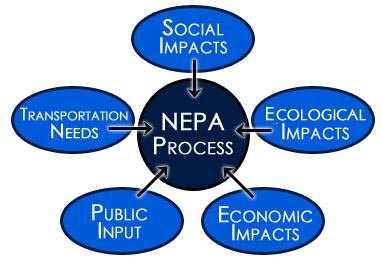
NEPA Requirements
- Study a reasonable range of alternatives based on “Purpose and Need”
- Use a systematic, interdisciplinary approach while evaluating environmental factors during the planning process
- Widespread interagency coordination, review, and consultation
- Documentation of the environmental analysis process in plain language
- Provide the public opportunity to participate and comment throughout the process
Three Types of NEPA Documents
| Environmental Evaluation (EE) | Categorical Exclusion (CE) | Environmental Assessment (EA) | Environmental Impact Statement (EIS) |
|---|---|---|
| Document approval in-house or by FHWA | Document approved by FHWA | Document approved by FHWA |
| Examination of project concept and location regarding potential for socioeconomic or ecological impacts | Unsure if significant impacts | Significant impacts |
| Determination of impact significance | Evaluation of key resources | More detailed evaluation |
| Finding of No Significant Impact (FONSI) | Record of Decision (ROD) |
Programmatic Agreement between ITD and FHWA Idaho Division Office
Approval of Actions Classified as Categorical Exclusions for Federal-Aid Projects
FHWA Links
- Categorical Exclusion
- NEPA Regulatory Framework and Process for Categorical Exclusion
- FHWA Environmental Review Toolkit
ITD Environmental Links
- Environmental Process ITD Flow Chart
- Environmental Process Manual
- Frequently Asked Questions for the ITD-654 Form
- NEPA Re-evaluations – 2024
Cultural
Cultural resources are the physical evidence or place of past human activity. They can include everything from archaeological sites to buildings, bridges, and canals to landscapes and places of traditional religious and cultural importance. ITD seeks to avoid, minimize, or mitigate adverse impacts to historically significant cultural resources. The ITD Cultural Resources Program ensures all ITD projects are in compliance with state and federal cultural resource protection laws.
ITD projects with federal funding, permitting, or land are required by Section 106 of the National Historic Preservation Act of 1966, and implementing regulations 36 CFR 800 to take into account the effects of project actions on historic properties. During this process ITD Cultural Resources staff define the Area of Potential Effect, make a good and reasonable faith effort to identify historic properties within that area, and assess any potential effects of the project on those properties. This process is completed in consultation with the Idaho State Historic Preservation Officer (SHPO), Tribal Historic Preservation Officers (THPO), Native American Tribes, local historic preservation commissions, and other interested parties.
For more information on the ITD Section 106 process, please refer to the Cultural Resources chapter of the Environmental Procedures Manual.
Those ITD projects with funding or approval from the Federal Highway Administration must also meet requirements of Section 4(f) of the Department of Transportation Act of 1966. Please see the Section 4(f) chapter of the Environmental Procedures Manual for more information on this process.
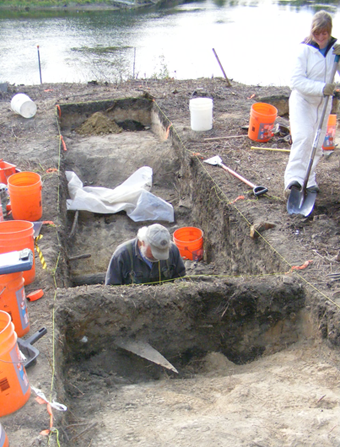 Archaeology is the study of past human activity through the recovery and analysis of material culture. The archaeological record consists of artifacts, ecofacts, features, and cultural landscapes which have been used by people of the pasts.
Archaeology is the study of past human activity through the recovery and analysis of material culture. The archaeological record consists of artifacts, ecofacts, features, and cultural landscapes which have been used by people of the pasts.
Archaeologists precisely record where all the clues of the past are found so they may reconstruct living surfaces, which may include house remains, fire-hearths, and refuse or garbage pits. Once the artifacts and their contexts are fully studied, researchers attempt to explain how past peoples and societies made a living and adjusted to changing social and environmental circumstances. Here are some examples of archaeological resources that ITD projects might encounter:
- Artifacts: stone tools, bone, ceramics, glass, and metals
- Ecofacts: animal bones, charcoal, plants, and pollen
- Features: fire hearths, refuse areas/trash dumps, rock art
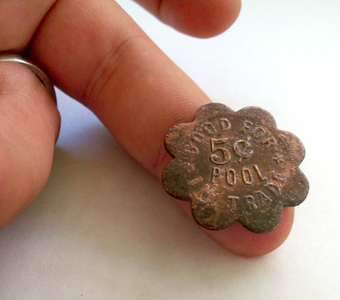
Once an archaeological site has been identified, archaeologists use the National Register of Historic Places criteria to determine if it the property has historic significance and can still convey it. Archaeologists determine if the property is associated with an important historic event or if it can yield more information about the past. Archaeologists complete a detailed recording of the site, document the site using photography and sketch maps, and conduct in-depth analysis of any artifacts, ecofacts, and features that are present to better understand how these were used by people of the past. ITD uses archaeologists to document sites that might be impacted by projects, determine if they have significance, and assess what impacts project actions might have on those properties.
Society for Historical Archaeology (SHA): ITD receives the Award of Merit for the Sandpoint Archaeology Project

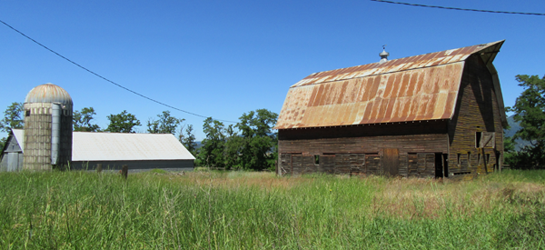 Architectural history is the study of the built environment and how surroundings can impact our lives. Certain properties remind us of our history and shared past. Here are some examples of architectural resources that ITD projects might encounter:
Architectural history is the study of the built environment and how surroundings can impact our lives. Certain properties remind us of our history and shared past. Here are some examples of architectural resources that ITD projects might encounter:
- Buildings: private residences, commercial properties, barns, schools, and courthouses
- Structures: bridges, roads, and irrigation canals
- Objects: monuments and boundary markers
- Sites: parks and cemeteries
- Districts: downtown Main Streets and residential neighborhoods
Once an architectural resource has been identified, architectural historians use the National Register of Historic Places criteria to determine if it the property has historic significance and still has the physical features necessary to convey that significance. 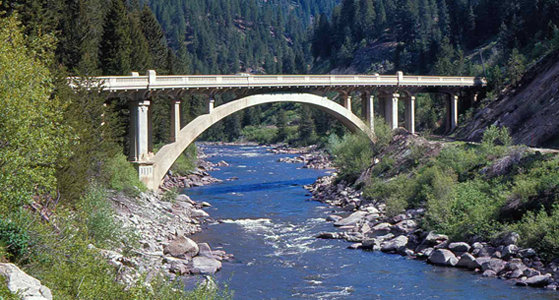 Usually these properties are at least fifty years old. Architectural historians determine if the property is associated with an important historic event or person; has a distinctive design, style, or construction; or if it can yield more information on the past. They also ask if the location, design, setting, materials, workmanship, association, and feeling of the property helps that property convey its significance to the general public. Architectural historians complete detailed written descriptions of the property, document the property using photography and sketch maps, and conduct in-depth archival research to better understand the local, state, or national significance of the property. ITD employs architectural historians to document properties that might be impacted by projects, determine if they have significance, and assess what impacts project actions might have on those properties.
Usually these properties are at least fifty years old. Architectural historians determine if the property is associated with an important historic event or person; has a distinctive design, style, or construction; or if it can yield more information on the past. They also ask if the location, design, setting, materials, workmanship, association, and feeling of the property helps that property convey its significance to the general public. Architectural historians complete detailed written descriptions of the property, document the property using photography and sketch maps, and conduct in-depth archival research to better understand the local, state, or national significance of the property. ITD employs architectural historians to document properties that might be impacted by projects, determine if they have significance, and assess what impacts project actions might have on those properties.
In 2008, ITD was awarded the Excellence in Historic Preservation award from Preservation Idaho for their work on the Idaho 55 Rainbow Bridge.
Historic Survey of Roads in Idaho’s State Highway System
This multi-volume publication illuminates the history and evolution of Idaho’s highway transportation network. These volumes have been developed as a way for the public and consultants to better understand the history surrounding Idaho’s state highway network, the individual highways, and to provide a consistent interpretation in applying National Register of Historic Places (NRHP) criteria to evaluate the significance, integrity, and eligibility of the current roads within this road system.
Volume 1 is the Historic Context and Volume 2 is the Application of the National Register of Historic Places Criteria for Evaluation. Volume 3, currently in development, will document individual highways and their specific history and assess their NRHP eligibility.
- Volume 1 – Historic Survey of Roads in Idaho’s State Highway System: Historic Context
- Volume 2 – Historic Survey of Roads in Idaho’s State Highway System: Application of the National Register of Historic Places Criteria for Evaluation
Idaho is a geographically, economically, and culturally diverse state. Our transportation system represents the shared history that helps to unite us. ITD has worked with consultants and local communities to prepare informative publications and resources about transportation history in the Gem State.
- The Weiser River Trail: To the Golden Heart of Idaho – This pamphlet summarizes the history of the Pacific and Idaho Northern Railroad and Weiser River Trail, Idaho’s Longest Rail-Trail, located in Adams and Washington Counties.
- Blaine County Transportation: A History of Bridges and Roadways in Blaine County, Idaho – This document identifies historic vehicular bridges in Blaine County and how these resources relate to the historic transportation infrastructure in the central Idaho.
- Marsing Oral History Project | “No Bridge, No Town” – Oral Histories on the Historic Snake River Bridge and the Town of Marsing: Agreed upon as an appropriate mitigation for the adverse effect to the historic Snake River Bridge near Marsing, Idaho, these interviews were conducted by the Owyhee County Historic Preservation Commission to preserve both the history of the bridge and life in early twentieth century Marsing.
- Idaho Transportation Photo Collection: This collection of over 30,000 images documents the rich history of transportation and infrastructure development in Idaho. The online, searchable database is free to the public.
- Idaho’s Highway History 1863-1975: Written in 1985 this document provides a brief synopsis of transportation in Idaho, including the history of the Idaho Transportation Department.
- The Other Side of Sandpoint – Early History and Archaeology Beside the Tracks: The Sandpoint Archaeology Project (2006-2013) was one of the largest historic archaeology projects in the western United States, and the largest archaeology project ever completed in the state of Idaho. It resulted in the recovery of over 600,000 artifacts associated with the early history of Sandpoint, Bonner County, Idaho. The four volumes include:
- 3) The Ethnography and Prehistory of Sandpoint (upon request), and
- Research Guide on Snake River Ferries: This document captures the history of ferry crossings and pioneer travel throughout Idaho’s Snake River region, including links to additional research materials on ferry crossings.
- US-95, Meadows Valley Transportation Corridor: Learn about the history of transportation routes and modes connecting Meadows Valley to Riggins.
- Steel Bridges in Eastern Idaho: Once commonplace but now rare, steel bridges in eastern Idaho heavily influenced the development and settlement of the region.
- History of Grace Dam Power Plant: One of three hydroelectric power plants in Caribou County, the Grace Dam Complex – including the dam, power plants, and penstocks – was built in 1906 and is still operational today, providing power to southern Idaho and northern Utah.
- From Forest to Field – Agriculture in Bonner County: Developed as mitigation for the adverse effect to a farmstead, this document is a detailed look at the agricultural industry in Bonner County. Visit the Bonner County History Museum to see this material on exhibit.
ITD has worked with local communities and historians to develop and install interpretative panels throughout the state.
Here are some interpretive signs you can see during your travels.
- Located about a half mile north of Grace, Caribou County, Idaho just on State Highway 34, are a handful of interpretive signs on the history of the Grace Dam Power Plant. Two, developed by ITD and the Local Highway Technical Assistance Council, share the history of the Turner Road Penstock Bridge and L.L. Nunn, the builder of the Grace Dam Power Plant.
- Located at the Rotary Park in McCall, Valley County, Idaho off of State Highway 55, are two signs about the history of the Lardo Bridge Crossing and Charles A. Kyle, one of Idaho’s most influential bridge engineers.
- Located on the south remnant of the Kootenai River Bridge in Bonners Ferry is an interpretive sign on Kootenai River crossings. Also in Bonners Ferry, installed near Bonners Ferry City Hall and in the vicinity of the Fairbanks Morris Generator, are two signs on the history of power and electricity in the region.
- Located along the Boise Greenbelt near Broadway Bridge in Boise, Ada County are multiple interpretive panels telling the history of crossing the Boise River and how it has impacted development and settlement. Thank you to the Boise City Department of Arts & History for providing these images.
- Located at the intersection of Railroad Avenue and Bridge Street in Sandpoint, Bonner County, are two signs documenting the history of the Northern Pacific Railroad in northern Idaho and its impact on the community of Sandpoint.
- Located at the Horseshoe Park in New Plymouth, Idaho along the route of US Highway 30, are six signs about the history of the William E. Smythe, the founding of New Plymouth, irrigation in the Payette Valley, and individuals important to the history of New Plymouth.
Idaho Transportation Department (ITD) – Key No. 19134:
US-93, 100 South Road, Jerome County
Appeal to the Advisory Council on Historic Preservation (ACHP)
- 19134 – Jerome | FHWA letter to ACHP, DRAFT REVIEW
- SHPO Submittal Letter
- Report+Attachments+Site Forms
- Memo Report 100 South (to SHPO) 6-14-2019
- SHPO Determination Letter – Adverse Effect
- District 4 – 19134 SHPO Memo Letter, FINAL signed
- SHPO Response 12-17-2019 | Re-Evaluation 100 South Road, Jerome County | SHPO Rev. 2019-689
- 19134 Project Information
Human & Physical Environment
Air Quality impacts are evaluated for all Idaho Transportation Department (ITD) federally funded transportation projects to determine if the project will cause or contribute to a violation of National Ambient Air Quality Standards. ITD’s mission is to improve air quality by ensuring all ITD projects and operations comply with federal, state and local air quality laws and regulations, and by promoting strategies which reduce emissions of motor vehicle pollutants.
ITD Air Screening Policy (Nov/Dec 2007)
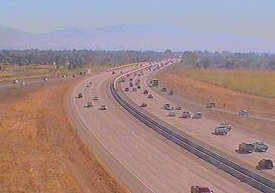
I-84 at Eagle Interchange
Links to Regulations and Guidance:
Idaho DEQ pages:
The Idaho Transportation Department must conduct hazardous materials investigations for any property ITD owns, manages, plans to sell, or plans to purchase. If hazardous materials are found to be present on ITD property, federal and state environmental laws requires ITD to cleanup and properly dispose of all hazardous materials regardless of whether the original source is from ITD activities, from a tenant, or inherited when property is acquired.
ITD seeks to identify hazardous materials early in the project development process through thorough investigations to reduce liability and to minimize delays. Advantages to this identification process include:
- Minimizing potential dangers to ITD and other personnel
- Protecting the environment from exposure to or spread of hazardous materials
- Minimize design and construction costs due to potential project delay or termination
- Reduce adverse publicity
|
|
|
HazMat Investigations are conducted in the following steps:
Administrative Review – (Required on all projects with the exception of Tier I Minor Projects)
- Use the Terradex Idaho site to conduct a project area “radius search”, with the search radii below in mind (a 1-mile radius is recommended).
- This is intended as a review of published lists to determine if there are any documented HazMat sites, underground storage tanks or contaminated groundwater within or adjacent to the project area.
| List Name | Abbreviation | Search Radius | Agency Contact |
|---|---|---|---|
| FEDERAL LISTS: | |||
| National Priorities List (Superfund) | NPL | 1 mile | EPA |
| Comprehensive Environmental Response, Compensation, and Liability Information System | CERCLIS | ½ mile | EPA |
| CERCLIS No Further Remedial Action Planned | CERC-NFRAP | ½ mile | EPA |
| Corrective Actions on Resource Conservation and Recovery Act Information Treatment, Storage and Disposal Sites | CORRACTS RCRA-TSD | 1 mile | EPA |
| Corrective Actions on Resource Conservation and Recovery Act Information Non-Treatment Storage and Disposal | CORRACTS RCRA non-TSD | ½ mile | EPA |
| RCRA Generators | RCRA | W/in or adj to ROW[1] | EPA |
| Emergency Response Notification System | ERNS | ROW only | EPA |
| STATE LISTS: | |||
| Solid Waste Management Facilities/Landfill Facilities | SWF/LF | ½ mile | Health Dept |
| Underground Storage Tank | UST | W/in or adj to ROW | DEQ |
| Leaking Underground Storage Tank | LUST | ½ mile | DEQ |
| Other | 1 mile | DEQ |
- Review the topography, groundwater levels and flows in the project area.
- Determine whether the site conditions warrant further investigation.
- Where warranted, the appropriate resource agencies are contacted (contact information is provided on the Terradex map at each site)
- If there is a potential risk, a Phase I or Phase 2 must be completed
Initial Site Assessment – (Phase I)
- Determines whether there is a potential HazMat risk
- Complete a Records Review of maps and historic documents to obtain information to help identify hazardous environmental conditions
- Perform a Site Reconnaissance to inspect property and any structures on the project for recognized hazardous environmental conditions
- Conduct Interviews with property owners or site managers to obtain information about possible hazardous environmental conditions that confirms information previously obtained or identifies new information
Preliminary Site Investigation – (Phase II)
- Confirm whether HazMat is present and extent of contamination
- Soil and water samples taken and analyzed
- Reports written to discuss physical environment and its relationship to potential contamination, sampling techniques, analysis results, health and safety considerations, identification of any contamination if found, conclusions, and remediation strategy and costs
Detailed Site Investigation – (Phase III)
- Conducted when existence of HazMat on the project site is confirmed
- Includes the Site Investigation, Remedial Action Plan and remediation
- Approximate clean up time can vary from 6 months to several years
- Authorization of a Phase III investigation will be coordinated through the Headquarters Environmental Section Manager
Additional information can be found under “1400 Hazardous Materials” in the ITD Environmental Process Manual
|
|
|
|
Tank Oil Spill – North of Smith Ferry, ID |
|
Traffic Noise is increased by heavier traffic volumes, higher speeds and a greater percentage of trucks. ITD environmental studies involving major highway improvements must analyze existing noise levels and predict future noise levels to determine noise impacts. All traffic noise studies prepared for ITD projects must adhere to procedures and requirements as established by federal law, Federal Highway Administration (FHWA) regulations, and ITD noise analysis guidelines.
Noise Forms
- Noise Barrier Abatement Checklist ITD-1055 Form
- Noise Abatement Decision Checklist ITD-1056 Form
- Optional Non-Barrier Noise Abatement Checklist ITD-1057 Form
Additional information concerning the Noise Policy can be found under “1300 Noise” in the Environmental Process Manual
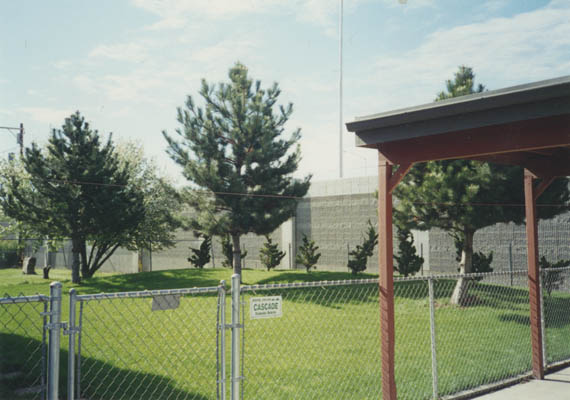 |
 |
| Noise Barrier / Sound Walls along I-84 | |
 |
 |
| Noise Barrier / Sound Walls along State Highway 55 | |
Natural Environment
Water of the U.S., Wetlands, Floodplains and Floodways, Wild and Scenic Rivers and Sole Source Aquifers
Wetlands – Section 404 of the Clean Water Act
Wetlands generally include swamps, marshes, bogs, and similar areas that are saturated by surface or groundwater and supports vegetation adapted for life in saturated conditions. They provide important functions including groundwater recharge, erosion control, shoreline stabilization, and fish and wildlife food and habitat.
Two Categories of Wetlands:
- Jurisdictional wetlands contain surface waters that have a connection to “Waters of the US”
- Non-Jurisdictional wetlands do not have a connection to “Waters of the US”
ITD’s policy is to avoid any activities that adversely affect wetlands during the design, construction, and maintenance of transportation projects. Appropriate action is taken to minimize and mitigate impacts that cannot be avoided.
Section 404 Permit – Required for discharging, dredging, or placing fill material within “Waters of the US” including wetlands to prevent quality degradation and overall loss of wetlands. Administered by the US Army Corps of Engineers (USACE).
Link to Regulations
Links to Guidance:
- ITD Environmental Process Manual
- Navigable Waters of the State list
- Programmatic Wetland Finding for Categorical Exclusions
- Wild and Scenic Rivers – FHWA Idaho Division Office Guidance
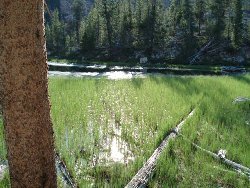
US Army Corp of Engineers (USACE) / Walla Walla District Information:
- Aquatic Resource Delineation Report – Template, June 2019 (Walla Walla District)
- Delineation Resources
- Guidance for Aquatic Resource Delineation Reports, June 2019
- Joint Application for Permit
- Jurisdictional Determination Request (Download) | Nov. 2023
- Section 10 Waters in Idaho
Link to FHWA Site:
Sole Source Aquifer
Threatened and Endangered Species (ESA), Essential Fish Habitat (EFH), Idaho Species of Greatest Conservation Need (SGCN), Migratory Birds, Wildlife Connectivity
The Biological program examines highway impacts on species listed under the Federal Endangered Species Act (ESA) and works with the Idaho Fish and Game, Fish and Wildlife Service (USFWS), Forest Service, Bureau of Land Management, and others for the purpose of preserving, protecting, and enhancing the state’s natural resources while operating, maintaining, and improving the state’s transportation system.
- For more information, see “Wildlife” tab above.
Threatened and Endangered Species (ESA)
| Biological Assessment | Programmatic Biological Assessment (PBA) | PBA Forms |
|---|---|---|
| • Biological Resources Personnel Qualifications | • Programmatic Biological Assessment (2022) • PBA Appendices (2022) • PBA Biological Opinion U.S. National Marine Fisheries Service (2022) • PBA Biological Opinion U.S. Fish & Wildlife Service (2022) • PBA Commitments Crosswalk Table | Go to ITD’s Form Finder web page – Use the numbers below to search & download the current ITD form(s). • ITD-289 form – PBA Pre-Notification • ITD-290 form – PBA Construction Monitoring |
More information to come for:
Idaho Species of Greatest Conservation Need (SGCN) and Migratory Birds
Resources
Memos & Standard Operating Procedures (SOPs)
- Environmental Memo 23-2: Environmental Document Submissions
- Environmental Memo 22-1: Endangered Species Act – Considerations of Candidate and Proposed Species and Proposed Critical Habitat
- Environmental Memo 22-2: Cultural Resource Material Clearance (Section 106)
- Environmental Memo 23-3: Environmental Emergency Procedures
- Saving to ProjectWise: Environmental Document File Naming Convention
Outside Agency Contacts
- Outside Agency Master List – May 2022
Planning & Public Involvement
To manage public outreach plans & activities, ITD staff need information, resources & recommended tools to implement & conduct an effective public outreach effort.
- Planning & Environmental Linkages (PEL) Procedures
- Public Outreach Planner (POP) – The POP is a tool for analyzing, quantifying & tracking public outreach needs, which will ultimately lead to appropriate & efficient project management.
- ITD Planning Information
Training
- Section 4(f) Training Materials | March 7-8, 2018
- Stormwater Inspector Training & Requirements
- 100.00 – Purpose and Overview
- 200.00 – Nepa Process Overview
- 300.00 – Environmental Documentation and Procedures
- 400.00 – State and Local Projects
- 500.00 – Process for Class II Projects
- 600.00 – Air Quality
- 700.00 – Water Quality/Surface Water
- 1000.00 – Wildlife, Fish, and Vegetation
- 1100.00 – Wetlands
- 1300.00 – Noise
- 1400.00 – Hazardous Materials
- 1500.00 – Wild and Scenic Rivers
- 1600.00 – Agricultural and Farmland
- 1700.00 – Public Lands Section 4(F), 6(F) and Forests
- 1800.00 – Historic, Archaeological and Cultural Resources
- 1900.00 – Social and Economic Conditions
- 2000.00 – Environmental Justice
- 2100.00 – Visual Impacts – Light And Glare
- 2200.00 – Secondary and Cumulative Impacts
Stormwater
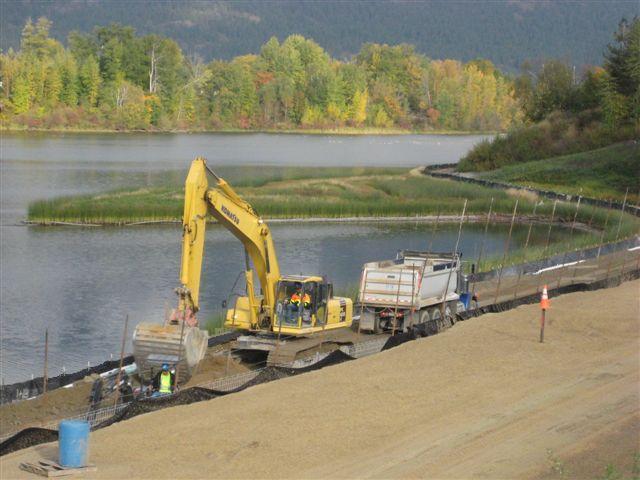 Stormwater runoff is rainwater or melted snow that runs off streets over land or impervious surfaces without percolating into the ground. As it flows, stormwater runoff collects and transports pollutants to surface waters. Some of these pollutants are visible such as sediment, motor oil and trash, as well as pollutants that are not easily visible such as dissolved metals, nutrients, oxygen demanding substances, and organic chemicals.
Stormwater runoff is rainwater or melted snow that runs off streets over land or impervious surfaces without percolating into the ground. As it flows, stormwater runoff collects and transports pollutants to surface waters. Some of these pollutants are visible such as sediment, motor oil and trash, as well as pollutants that are not easily visible such as dissolved metals, nutrients, oxygen demanding substances, and organic chemicals.
Although the amount of pollutants from a single residential, commercial, industrial or construction site may seem unimportant, the combined concentration of contaminants threaten our lakes, rivers, wetlands, and other water bodies. Pollution conveyed by stormwater degrades the quality of drinking water and damages fisheries and habitat of plants and animals that depend on clean water for survival. Pollutants carried by stormwater can also affect recreational uses of water bodies by making them unsafe for wading, swimming, boating, and fishing.
- Go to Resources tab to access the ITD stormwater Best Management Practices (BMP) Manual.
- Go to itdprojects.idaho.gov for information about current and upcoming construction projects.
- Go to Adopt-a-Highway Program for volunteer information.
Clean Water Act (CWA)
In 1972, Congress passed the Clean Water Act (CWA) “to restore and maintain the chemical, physical, and biological integrity” of the Nation’s waters. The CWA set the basic structure for regulating discharge of pollutants into waters of the U.S.
National Pollutant Discharge Elimination System (NPDES)
One of the ways the CWA sought to regulate discharges of pollutants to waters of the U.S. was through the National Pollutant Discharge Elimination System (NPDES) permitting program. NPDES permits contains limits on allowable discharges, monitoring and reporting requirements, and other provisions to ensure that discharges do not harm water quality or public health.
Idaho Pollutant Discharge Elimination System
Authority to implement the NPDES program in Idaho was delegated to the Idaho Department of Environmental Quality (IDEQ) in phases beginning on July 1, 2018 until completion on July 1, 2021. Thus, the CWA implemented in Idaho is now called the Idaho Pollutant Discharge Elimination System (IPDES) on all non-tribal lands. The Environmental Protection Agency (EPA) still retains authority to permit NPDES activities on tribal lands in Idaho.
Idaho Transportation Department (ITD) has coverage under three different types of CWA permits, including:
- IPDES Construction General Permit (CGP) – Construction activities that disturb greater than one acre of land or are part of a larger common plan of development on non-tribal lands and have the potential to discharge stormwater to waters of the U.S. and are regulated by the IDEQ.
- NPDES CGP – Construction activities that disturb one acre or more of land or are part of a larger common plan of development on tribal land and have potential to discharge stormwater to waters of the U.S. and are regulated by the EPA.
- Municipal Separate Storm Sewer System (MS4) Permits – Stormwater drainage from roads or property that drains into conveyance systems owned by a municipality that meets certain criteria of population size and discharges into waters of the U.S. and are regulated by the IDEQ.
Go to ITD’s Form Finder web page – Use the numbers below to search & download the current ITD form(s).
Construction General Permit (CGP) Projects requiring a Stormwater Pollution Prevention Plan (SWPPP)
ITD-2741 Form – Construction Stormwater Site Evaluation Worksheet
ITD-2784 Form – Stormwater Site Assessment (for Design)
ITD-2950 Form – Stormwater Pollution Prevention Plan (SWPPP) Narrative for Construction Activities
Guidance
Stormwater Runoff Action Items Tool
Buffer Design Decision Flow Chart
Buffer Calculation Presentation
Buffer FAQs
ITD-2788 Form – Pollution Prevention Plan Template
Contractor Notes (CN)
CN Winter Shutdown
• 2023 Standard Specifications for Highway Construction
Go to ITD’s Form Finder web page – Use the numbers below to search & download the current ITD form(s).
Inspection
ITD-2802 Form – Stormwater Compliance Inspection Form (CGP Projects)
ITD-2960 Form – LHTAC Transfer of SWPPP Inspection Responsibility
ITD-2960-Instructions – LHTAC Transfer of SWPPP Inspection Responsibility (Instructions)
ITD-2790 Form – Notice of Potential Violation of the CGP or Notice of Prohibited Discharge
SWPPP Management
SWPPP Management Process Overview
ITD-2950 Form- SWPPP Template, ITD-based Format
ITD-2951 Form – Contractor or Local Entity CGP Signature Authority
ITD-2952 Form – ITD Delegation of CGP Signature Authority
ITD-2953 Form – Corrective Action Reporting Tables
ITD-2954 Form – Subcontractor Certification of SWPPP
ITD-2955 Form – SWPPP Modification Log
ITD-2956 Form – Grading and Stabilization Activities Log
ITD-2957 Form – Signature Sheet (Modifications and/or Corrective Action Reports)
ITD-2958 Form – SWPPP Training Log
ITD-2961 Form – Contractor Request to File Notice of Termination
Non-CGP Projects (PPP)
ITD-2786 Form – Construction Site Inspection Report
ITD-2789 Form – Stormwater Document Change Request
ITD projects with CGP coverage require Inspectors with current ITD Inspector Qualification and a Contractor representative with current ITD-approved Water Pollution Control Manager Training.
Water Pollution Control Manager
Course Length: 16 Hours
ITD requires all Contractors to designate a Water Pollution Control Manager (WPCM). The WPCM must attend an ITD-approved 16-hour stormwater management training course. This course has been developed to align with the 2022 CGP. Offerings are available at the following link.
AGC WPCM Training: http://web.idahoagc.org/events
Consultants – Construction Engineering & Inspection – Stormwater Inspector
To certify, complete the ITD Inspector Qualification Training course – or – the Idaho Associated General Contractors (AGC) WPCM Training course (see above). Those who complete the AGC course must also submit an Inspector Qualification Registration Form ITD-2905, found in the ITD’s Contract Administration (CA) Manual, Section 114 or ITD’s Form Finder web page and a copy of their WPCM course completion certificate to:
Idaho Transportation Department
Attention: Training & Development
P. O. Box 7129
Boise, Idaho 83707-1129
ITD Stormwater Training
ITD Inspector Qualification Training
Course Length: 16 hours
This course is required for ITD Construction Engineers, project managers, project inspectors, and maintenance staff to complete mandatory stormwater management training.
Contact Information
- For complaints or illicit discharges on the highway, please call: 208-772-1200
- For complaints or illicit discharges in the City of Coeur d’Alene, please call: 208-676-7405
For specific stormwater topics:
- Ryan Hawkins – Municipal Separate Storm Sewer System Permit – Hazardous Materials, Illicit Discharges, Illegal Connections, and Illegal Dumping
- Michael Hartz – Construction General Permit
Other Permittees in the MS4 Phase II Area
Municipal Separate Storm Sewer Systems (MS4) Permits
In some cases ITD is listed as a co-permittee with local municipalities that share or are connected to the same MS4 conveyance system.
Annual MS4 Permit Reports
Annual reporting is required for MS4 permit holders.
Phase II – District 1
- 2024-2025 Annual Report
- 2023-2024 Annual Report
- 2022-2023 Annual Report
- 2021-2022 (placeholder)
- 2020-2021 (placeholder)
- 2020 Annual Report
- 2019 Annual Report
- 2018 Annual Report
- 2017 Annual Report
- 2016 Annual Report
- 2015 Annual Report
- 2014 Annual Report
- 2013 Annual Report
- 2012 Annual Report
- 2011 Annual Report
- 2010 Annual Report
- 2009 Annual Report
Contact Information
- For complaints or illicit discharges on the highway, please call: 208-799-5090
- For complaints or illicit discharges in the City of Lewiston, please call: 208-298-3900
For specific stormwater topics:
- Eric Hendren – Municipal Separate Storm Sewer System Permit – Hazardous Materials, Illicit Discharges, Illegal Connections, and Illegal Dumping
- Neal Scott – Construction General Permit
To report a release of materials that pose an immediate threat to life or a significant threat to the environment, please notify the Idaho Department of Environmental Quality (DEQ) via calling emergency dispatch services. For other environmental concerns, fill out:
Public Education
- Storm Water Pollution Compliance
- Erosion Sediment Guide
- Hazardous waste disposal?
- Learn more at: Transfer Station, City of Lewiston
- Chemical Storage and Spill Response Flyer
- Earth Day litter pickup article
- Litter pickup?
- Go to: Adopt-A-Highway program
- Street Sweeping Practices in District 2
- 2023 Standard Specifications for Highway Construction (See Section 107.17)
Other Permittees in the MS4 Phase II Area
Annual MS4 Permit Reports
Annual reporting is required for MS4 permit holders.
- 2023-2024 Annual Report
- 2022-2023 Annual Report
- 2021-2022 Annual Report
- IDS-02825 | Compliance Letter
- 2020-2021 Annual Report
Phase II – District 2
ITD Phase I and Phase II MS4 – For complaints please call: 208-334-8300
- Greg Vitley – Municipal Separate Storm Sewer System Permit-Hazardous Materials, Illicit Discharges, Illegal Connections, and Illegal Dumping
- Chris Branstetter – Construction General Permit
- Public Education
What to do with household hazardous waste? Learn more at Household Hazardous Waste | City of Boise
Phase I – District 3
Municipal Separate Storm Sewer Systems (MS4) Permits
In some cases ITD is listed as a co-permittee with local municipalities that share or are connected to the same MS4 conveyance system. ITD District 3 is a partner of the Partners for Clean Water group with local MS4 co-permittees. | Partners for Clean Water
If you’d like to speak to someone, you can call the Stormwater Pollution Prevention hotline at 208-395-8888. | Partners for Clean Water – Report an Issue
- Phase I Permit – IDS027561
- Permit Area Map
- Phase I Storm Water Management Program
- Other Permittees in the IPDES MS4 Phase I Area
Annual MS4 Permit Reports
Annual reporting is required for MS4 permit holders.
Phase II – District 3
Annual MS4 Permit Reports
Annual reporting is required for MS4 permit holders.
- District 3 Phase II Stormwater Management Plan (SWMP)
- To comment on the SWMP contact Greg Vitley at: Greg.Vitley@itd.idaho.gov
- ITD District 3 Phase II MS4 Annual Report – April 2023
- ITD District 3 Phase II MS4 Annual Report – April 2022
Other Permittees in the NPDES MS4 Phase II Area
Municipal Separate Storm Sewer Systems (MS4) Permits
In some cases ITD is listed as a co-permittee with local municipalities that share or are connected to the same MS4 conveyance system.
• District 5: Permit no. IDS-028053
Annual MS4 Permit Reports
Annual reporting is required for MS4 permit holders.
Phase II – District 5
• 2022-2023 Annual Report
• 2019-2020 Annual Report
• 2017-2018 Annual Report
• 2016-2017 Annual Report
• 2015-2016 Annual Report
• 2014-2015 Annual Report
• 2013-2014 Annual Report
• 2012-2013 Annual Report
• 2011-2012 Annual Report
• 2010-2011 Annual Report
• 2009-2010 Annual Report
• 2008-2009 Annual Report
• 2007-2008 Annual Report
• 2006-2007 Annual Report
Municipal Separate Storm Sewer Systems (MS4) Permits
In some cases ITD is listed as a co-permittee with local municipalities that share or are connected to the same MS4 conveyance system.
Annual MS4 Permit Reports
Annual reporting is required for MS4 permit holders.
Phase II – District 6
• 2022-2023 Annual Report
• 2021-2022 Annual Report
• 2020-2021 Annual Report
• 2019-2020 Annual Report
• 2018-2019 Annual Report
• 2017-2018 Annual Report
• 2016-2017 Annual Report
• 2015-2016 Annual Report
• 2014-2015 Annual Report
• 2013-2014 Annual Report
• 2012-2013 Annual Report
• 2011-2012 Annual Report
• 2010-2011 Annual Report
• 2009-2010 Annual Report
• 2008-2009 Annual Report
Wildlife
Idaho is home to finned and furred animals that make the state a sought-after place to live and visit. Like humans, wildlife also travel and traverse across highways in search of food, better habitat, or mates, which can result in significant concerns for public safety. Each year there are an average of 1,010 crashes involving wildlife on highways and interstates. These crashes can result in the mortality of wildlife as well as human fatalities. Some years no human fatalities are recorded; however, most years between one and four people are killed as a result of a wildlife-vehicle collision.

ITD develops projects and works with agency partners like the Idaho Department of Fish and Game (IDFG) to reduce risk. Wildlife mitigation for that risk is often required through environmental processes during project development.

The type of crossing structure depends on a number of factors. The department works with IDFG to analyze data including roadkill or carcasses, crashes, traffic volumes, migration and movement routes and more. Once a need is established, the agencies coordinate on what type of crossing is appropriate; some larger animals, like elk, are more comfortable using overpasses than underpasses.
ITD also identifies infrastructure that restricts the movement of fish. Steep or undersized culverts can prevent fish from moving upstream to access spawning habitat, find food or escape predation or stranding.
Funding for wildlife crossings primarily comes from competitive federal grants; no dedicated state funding is available. Projects are primarily identified by staff at regional offices based on demonstrated need.
Highway infrastructure can inadvertently limit the movement of fish to access habitat to spawn, search for food, migrate or escape predation. Culverts can be too steep or too small, creating faster flows that make it difficult for fish to swim upstream; they can also be perched too high above the channel and prevent fish from moving upstream.
When planning projects to improve existing highways, ITD actively looks to remove these barriers, often by replacing culverts with bridges or modifying culvert designs.
The department has also pursued federal grant opportunities in the absence of dedicated state funding to construct improvements specific to fish passage without being paired with highway improvements. Several projects are currently scheduled to improve fish passage, primarily in the Lewiston region that has the most habitat and population of endangered steelhead and salmon.
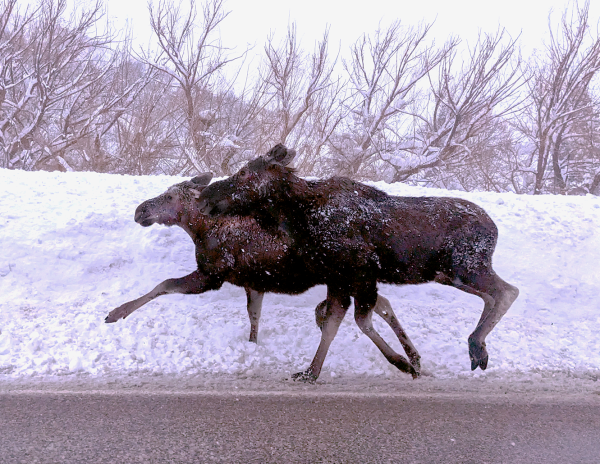
- Ongoing construction on U.S. Highway 95 near McArthur Lake will replace a box culvert with a longer bridge with greater vertical clearance to allow wildlife to pass underneath the highway to access the wildlife refuge.
- Also in North Idaho, IDFG received a grant in 2023 for $250,000 to work with the community in Osburn to transform an Interstate 90 overpass into a crossing for elk and other large animals. No date has been set yet for construction as plans must be completed and additional funding identified.
- The department is seeking grant funding for an underpass on U.S. Highway 30, Rocky Point Wildlife Crossing, south of Montpelier and targeting construction in 2025 to prevent collisions with wildlife, primarily mule deer. About 100 mule deer are struck by vehicles every year as they cross from summer habitat in the Caribou Mountains to winter habitat in the Bear Lake Plateau.
A statewide study is underway to identify hotspots for wildlife-vehicle collisions and to then develop a list of prioritized areas of major concern on state highways and interstates. The study will help the department pursue federal funding for improvements and is expected to be finished in summer 2024.
Completed projects
Projects to reduce wildlife-vehicle collisions and improve habitat connectivity have been constructed in many locations statewide, including most recently on State Highway 21 near Lucky Peak State Park.
- Outdoor Idaho episode: Right of Way – Wildlife habitat and crossings including the new SH-21 Cervidae Crossing
Big game began using the overpass as soon as it was constructed in late 2023 to safely pass over the highway without posing a threat to drivers. The project was funded by a $7.2 million federal grant and is expected to reduce wildlife-vehicle collisions by 80 percent.

Wildlife crossings videos
See YouTube videos below about constructed projects that have proven to be successful functional crossings. These videos were made in conjunction with the Yellowstone to Yukon Conservation Initiative.

